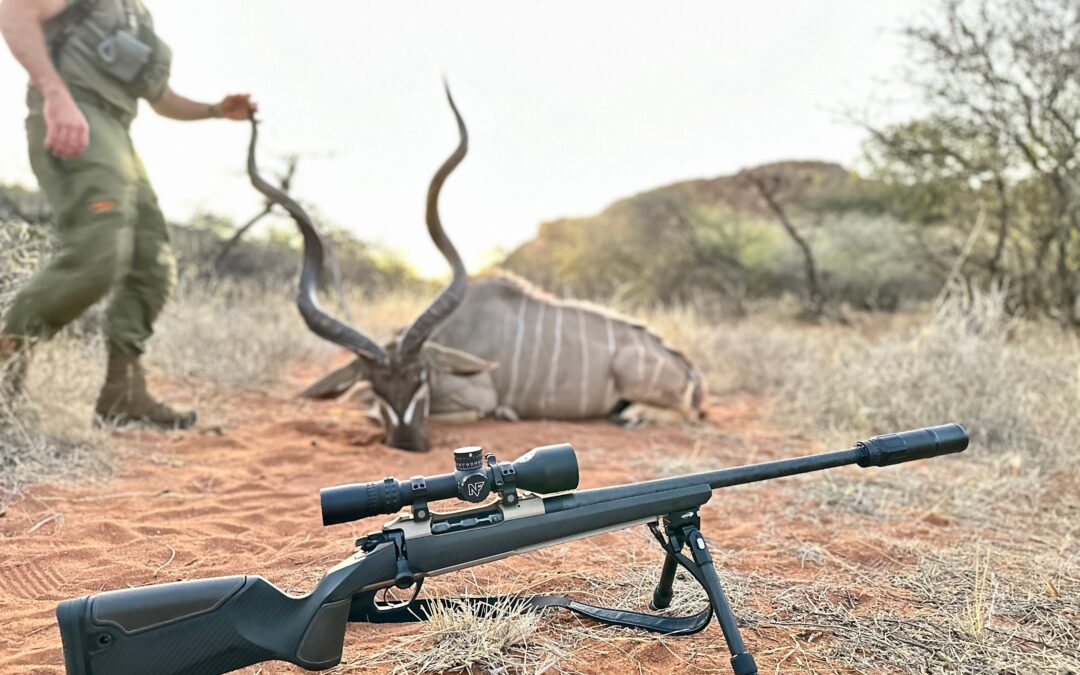By Reid Scott
Long range shooting and African hunting. Like whiskey and tonic, surely those two things do not mix. They might both have their merits, but how can one channel their inner Hemmingway while carrying a synthetic rifle topped by an optic that looks like it was designed for stargazing? And yet, perhaps these two worlds are not so far apart.
In recent years, the shooting world has been consumed by long-range fervor. Everywhere you turn, sub-MOA guarantees and bigger optics vie for your attention. Since laser rangefinders have eliminated the black art of calculating distance, long range shooting has become obtainable to the common man without taking out a loan to cover the equipment and the schooling.
I’ll confess, the long range bug bit me too. More and more, I wanted to test my own limits and see how far away I could make a tiny bullet land just where I intended. Eventually, I found that with the correct equipment and quality instruction, I could confidently guarantee shots that I would have labelled unconditionally irresponsible before. As any good friend does, I convinced my buddies to sample some of the addiction. Soon enough my good friend Matt and I were spending an obscene amount of time training and shooting, and were quickly becoming the, “Shooter ready, spotter up,” duo.
Now enter African hunting. Surely a place for a good walnut stock and big calibers, if there ever was one. In fact, we were assured of several things: First, our carbon fiber tripods would be useless in the bushveld. Second, shots would be fast and close, with no time for dialing long range optics. Third, our little 6.5mm bullets would only maim the durable African game, and even if they did take down some animals, it just wouldn’t be in line with tradition. After all, Mr. Ruark had a few words to say about bringing enough gun to Africa.
Fortunately our hosts, the Knott family at Greater Kuduland Safaris, were willing to suffer us with an open mind. We arrived and requested to zero and true our rifles, both to confirm that the abusive airlines had not damaged them, and to prove to our hosts that we were not completely full of bull. We utilized their lovely runway as an improvised long range, and set up an impala-vitals-sized-rock against a berm at 600 yards.
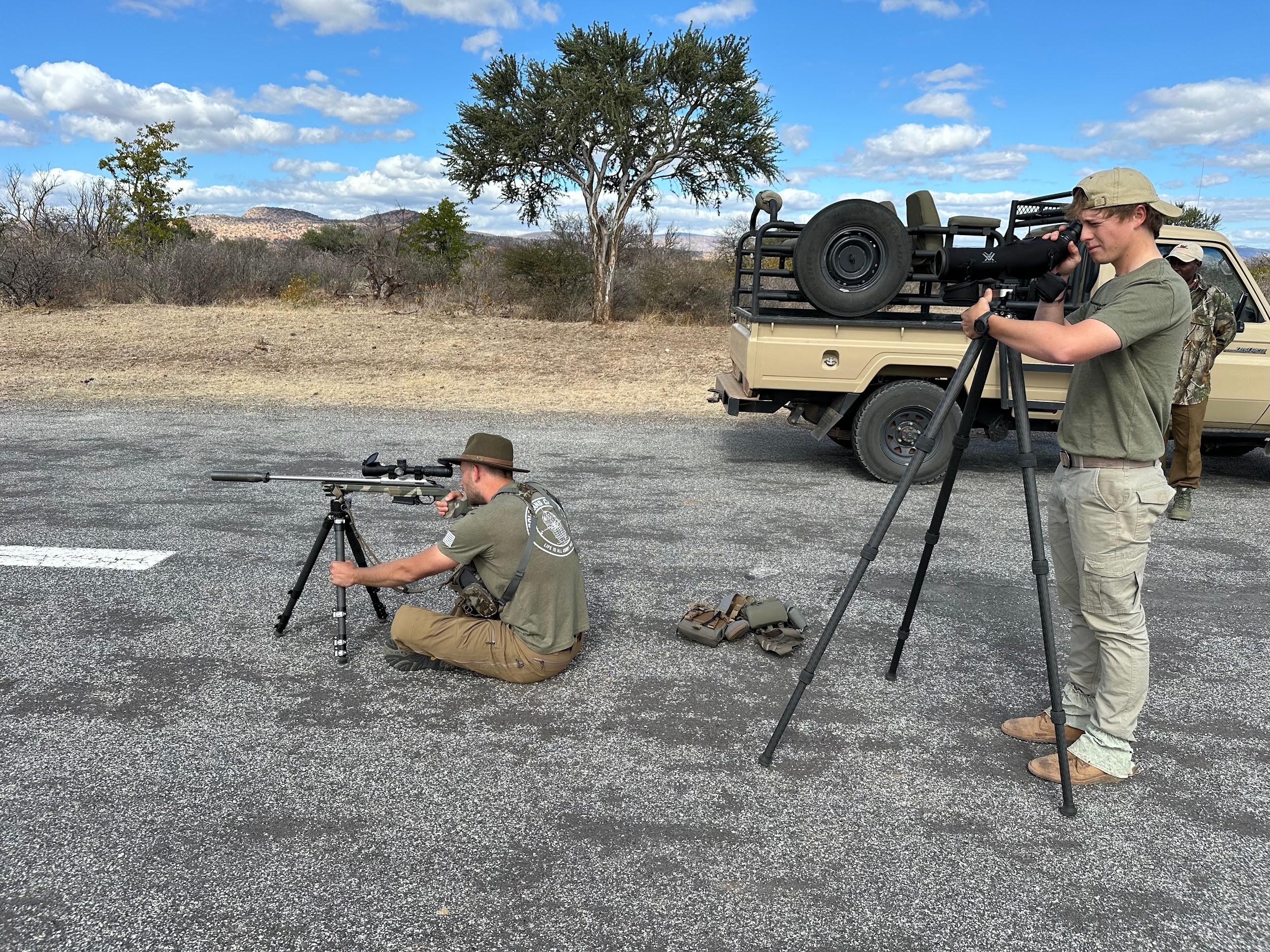
Gavin Knott spots for the author.
We each landed fist-sized groups on the stone, but the real proof was yet to come. I’m nothing special; if I can do it, you can do it. To demonstrate, we convinced both the seasoned legend, Howard Knott, and his immensely capable son Gavin to take a turn behind the rifle. Within moments, they were both making consistent hits at a range they would have previously considered unthinkable.
The Knott family’s Limpopo property is a long range hunter’s dream come true. The land is generally flat, punctuated by high rocky ridges crisscrossing the area. This results in largely predictable wind, but elevated shooting positions that provide beautiful vantage points for almost any location. From these points, we were able to spot and stalk, or spot and shoot when stalking was not feasible.
Working as a team on these longer shots provides much of the joy. Several days into the hunt, we clambered to the top of a ridge and glassed a lovely kudu nearly 500 yards from our perch. So often the case in hunting, the animals proved uncooperative. After a considerable amount of dialing and redialing, adjusting and readjusting to the changing wind and position of the animals, the kudu stepped out from behind the Mopani trees and provided a beautiful broadside shot. Matt gave the final distance of 465 yards and the appropriate wind call, and despite my sweaty palms and excitement, the shot broke smoothly. Other than a slight kick, the kudu barely reacted. It then walked just a couple steps before disappearing behind some rocks.
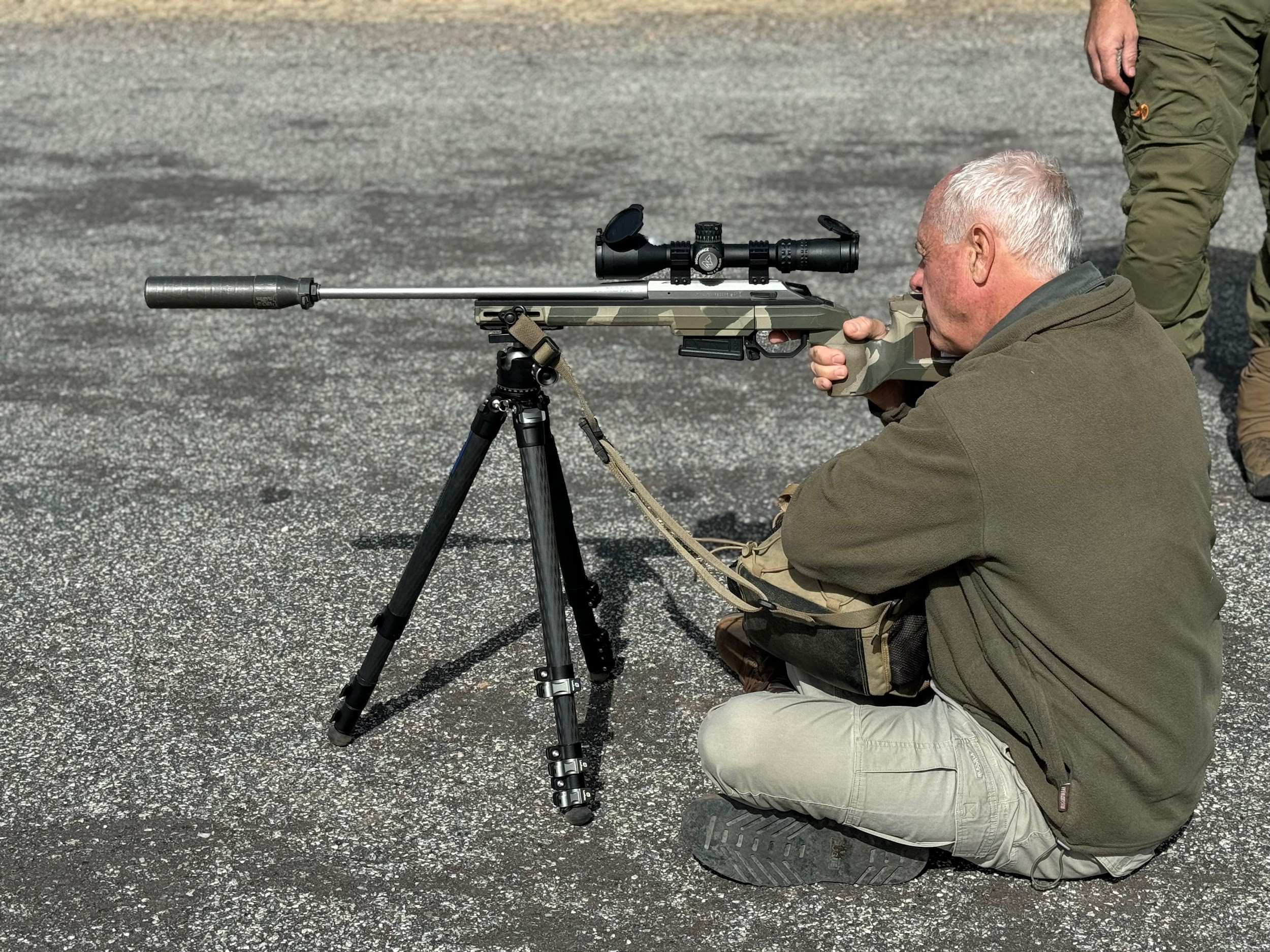
Howard Knott making hits at 600 yards using the author’s rifle.
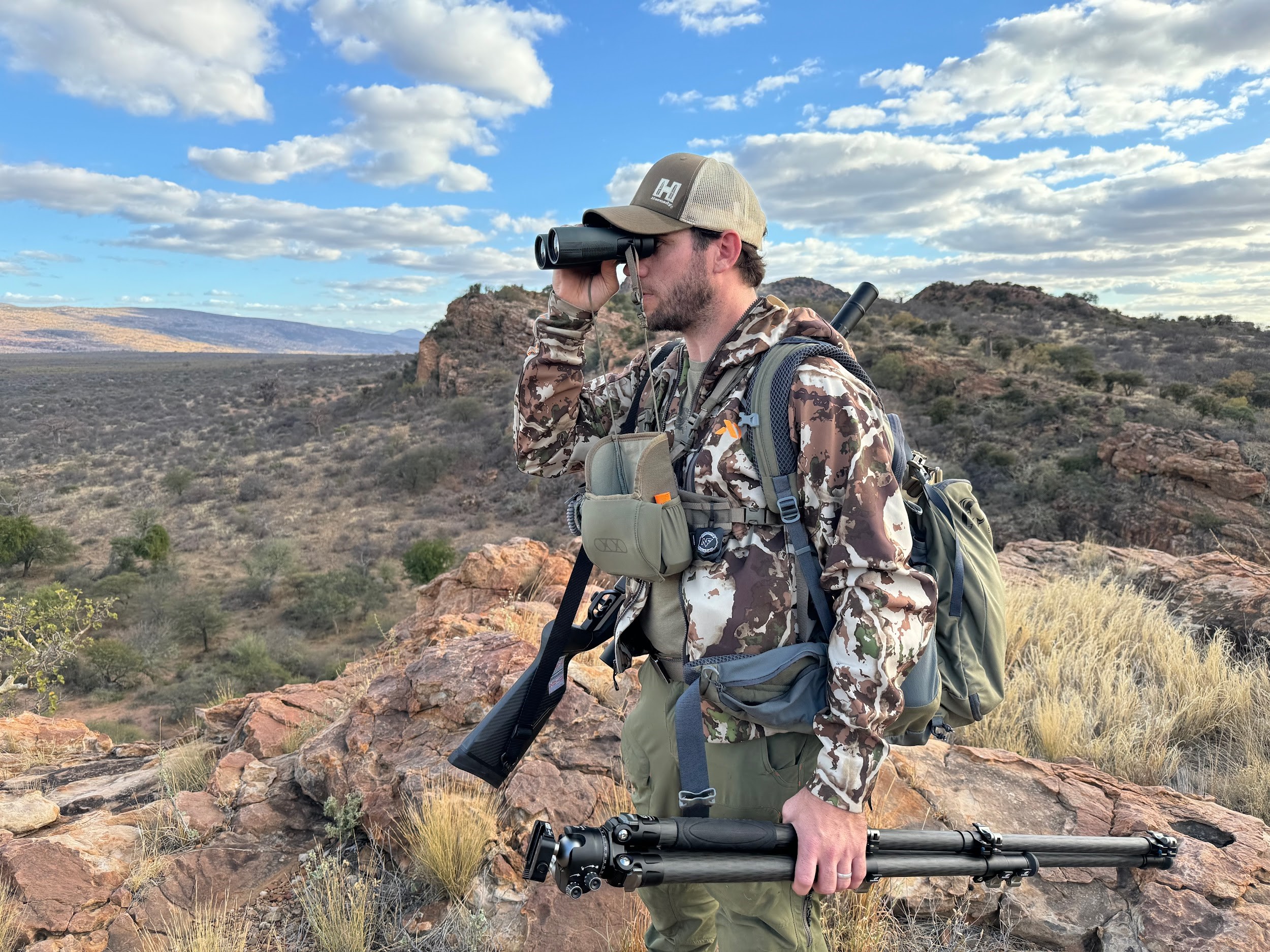
These ridges provided beautiful shot opportunities.
All the training in the world does not, however, alleviate that churning feeling in your gut while you wait to determine the validity of your shot. It made for a long walk, climbing down the ridge and closing those 465 yards to the point of impact. While I felt great about the shot, it’s easy to start doubting yourself as the minutes go by.
Fortunately, all my concern was for nothing. There was the kudu, with a perfect little hole through the shoulder just steps from where we last saw it. My trepidation turned to relief, and I was grinning like an idiot. It is worth noting that the miniscule 6.5mm bullet, a Hornady ELD-X, performed impeccably at this range. It mushroomed and exited, and resulted in a perfect outcome.
Naturally, Matt felt the necessity to prove his shooting skills superior to mine, and in the failing light one of the final days of our safari, Gavin pointed out a very nice old impala ram. It was feeding our direction, over 600 yards away. Our rocky perch was too tight to shoot from prone, but our adjustable tripods saved the day here.
Admittedly these lock-in tripods are an unusual piece of gear for this type of hunting, but we found them to be worth their weight in gold. Multiple times we set up over tall grass or on broken terrain, adjusting a bit here, a bit there, for precisely the right hold. While they certainly do not have the rustic panache of wood and leather shooting sticks, form follows function, and we were certainly happy to have that function here.
As the ram came slowly closer, Matt set up his tripod on the rocky outcropping for a seated shot. He maneuvered so that he could sit back against the boulders and steady himself, wedging his daypack under his shooting arm for added support. At 505 yards, the impala reversed course and began moving away. With the daylight rapidly escaping, this was the last possible moment for success. The shot broke crisply on Matt’s fancy Gunwerks rifle, and the ram never took another step. I had to endure the flight home hearing all about how any rookie could take a 465 yard shot, but it takes a real marksman to shoot beyond 500!
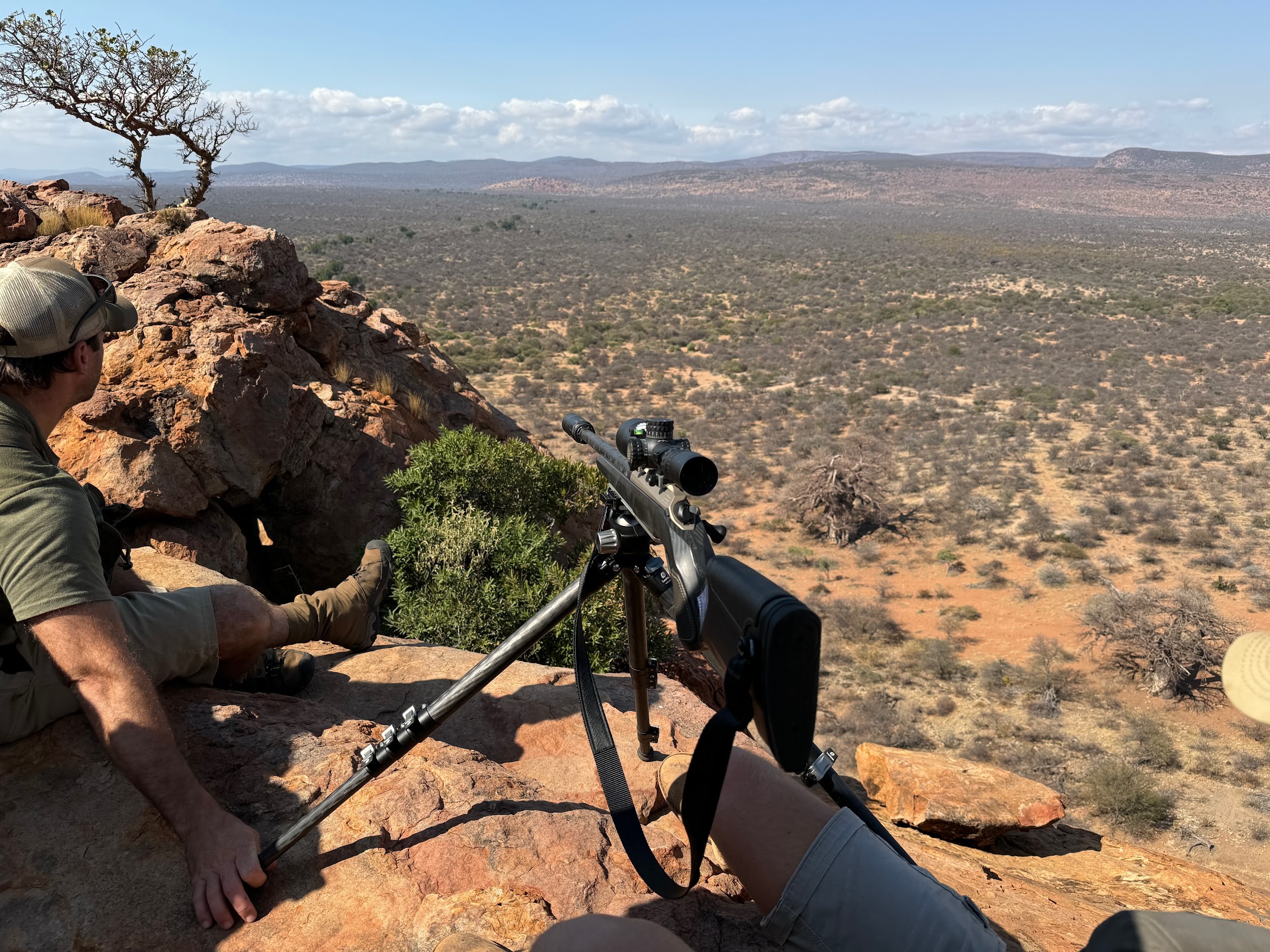
Adjustable lock-in tripods allowed for irregular shots that would have been impossible otherwise.
At this point, I recognize that I’ve likely irritated both the long range hunters and the African hunting purists: one group, because 500 yards is not far enough to really count as long range, and the other group because they consider 500 yards to be much too far! At the risk of exiting this discussion without friends on either side of the aisle, I’ll simply state that we hoped to strike a balance between the two, and pulled the trigger only when we were confident of the outcome. We had regularly trained out to 1200 yards, but kept our shots to within half that distance.
While we took many other remarkable animals at normal distances, the intersection of long range and African game leapt out as an extremely rewarding and welcome addition to our safari. We will absolutely be back to continue our journey into precision hunting, but I should admit, that want does war against a strange desire to bring exclusively wood stocked and iron sighted rifles next time.

The author with a decidedly un-African rifle. He got the hat correct, at least.
Perhaps that is exactly what makes hunting in Africa so unique and addicting; it is simultaneously new and old, modern and traditional.
If you have not already begun your long range journey, I strongly encourage you to start! You will undoubtedly find it rewarding, and it pairs remarkably well with the pursuit of African animals. As for me, I am happy to mix the two. My whiskey and tonic, on the other hand, will remain nicely apart.

